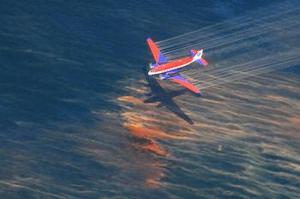Oil spillsLearning the lessons of the BP oil spill
In an attempt to limit the harm of the Deepwater Horizon oil spill in the Gulf of Mexico in 2010, three million liters of dispersant were used to dissipate the oil; on the surface the damage seems limited, but the seabed is covered with a thick layer of gunk; scientist from around the world are now working on models that can be consulted by decision makers when there is another oil spill disaster

Aircraft spreads dispersant over spilled oil // Source: sirius-tech.cn
In an attempt to limit the harm of the Deepwater Horizon oil spill in the Gulf of Mexico in 2010, three million liters of dispersant were used to dissipate the oil. “The question is whether that was the best approach,” said Tinka Murk, Professor of Environmental Toxicology at Wageningen University. On the surface the damage seems limited, but the seabed is covered with a thick layer of gunk.
“There were no detailed contingency plans in place during the BP oil spill,” said Murk. Therefore, ad hoc decisions were taken. Scientist from around the world are now working on models that can be consulted by decision makers when there is another oil spill disaster. “The Decision Support Tool should provide insight in what the effects are of different measures to get rid of the oil. Not only the visible effects, but also those below the surface,” says Murk.
A Wageningen University release reports that the idea was that dispersants would dissolve the oil and that what was left would be strongly diluted in the sea water. This would cause very little environmental damage. It appears, however, that a lot of dirt has sunk in flakes to the bottom of the Gulf of Mexico, forming a thick layer gunk on the seafloor. Life on the seabed, and thus the entire ecosystem, is suffering severely from this pollution. So, although the visible damage of the disaster is relatively limited, considering that during a period of three months millions of gallons of oil flowed into the sea, out of sight, at 800 meters depth, a significant environmental disaster is occurring.
With colleagues from Wageningen UR and the Northern College Leeuwarden, Murk examines the effects of dispersants on the oil and on the environment. This research is done within the international C-IMAGE consortium, the Center for Integrated Modeling and Analysis of the Gulf Ecosystem, which was founded to learn from the disaster with the Deepwater Horizon. This consortium comprises researchers from 13 universities and institutes, including Wageningen University and IMARES Wageningen UR. BP, owner of the Deepwater Horizon and thus responsible for the environmental disaster, finances the research.
Dispersant works differently in sea water than in clean water
Recently, the Dutch C-IMAGE team, led by Tinka Murk, discovered that the dispersants are not as effective in real sea water (containing algae and other particles) as they are in clean water. “In sea water we see cobweb-like
